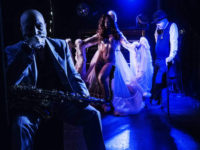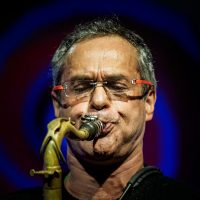Erodoto Project features mainstays Bob Salmieri and Alessandro de Angelis and is named after the Italian translation of Herodotus. Erodoto is perhaps the first curious reporter, trying to fathom the history of the Mediterranean.
Here, the band is enhanced with Murizio Perrone on double bass, Giampaolo Scatozza on drums, Carlo Colombo on percussion and the Miro String Trio including Fabiola Gaudio on violin, Lorenzo Rundo on viola and Marco Simonacci on violoncello.
Mythos – Metamorphosis is the third chapter of Erodoto Project’s saga dedicated to the myths and legends of the Mediterranean, following Lands, Men and Gods and Molon Labe (Come and Get Them).
Due on May 1, 2020 via Cultural Bridge, the album begins with the sax-led “Meleagro,” which features a melodic line that rises and falls, shading out to allow an extensive Rhodes solo in the central section that’s supported by the rest of Erodoto Project. Bob Salmieri’s sax then re-enters and makes way quickly for Giampaolo Scatozza’s drum solo, before the theme is re-introduced first by bass and then by the sax, taking the piece to a calm ending.
“Aci e Galatea” is based on the poignant events of Aci and Galatea, where the jealous Cyclops slays the mortal Acis, beloved of the sea nymph Galatea; she then transforms Acis’ blood into the shape of a river spirit. The song introduces a slightly off-beat melody over Maurizio Perrone’s wonderful flowing bass and Carlo Colombo’s light percussion. Keyboard takes the lead for much of “Aci e Galatea” and, at times, the hammered strings of Alessandro de Angelis’ piano create a lovely contrast with the bowed, deep strings of bass. The melody sings and sighs overhead, playing with and changing the basic rhythm patterns in the theme. Each instrument seems to take a character from the tale.
“Ifi e Iante” is an easy going, strolling number. Into the laid back theme are introduced changes of tempo, as Erodoto Project sashays along. The interesting harmonics of the Rhodes are superseded by Bob Salmieri’s sax once again, taking the lead and taking the number up with easy riffs and phrasing. “Siballa Cumana” is atmospheric and based on tales of a priestess who oversaw the oracle of Apollo at the Greek colony of Cumae, near Naples. The track explores Eastern overtones and some string additions which completely blindside the listener, coupled as they are over the sultry woodwind and all in a 3/4 rhythm pattern.
Erodoto Project’s “Pasiphae,” on the other hand, is more conventional with strong rhythmic patterns, and harmonic sections between piano and tenor. The percussive elements add another dimension. Alternating changes between piano and sax led sections are intriguing, as is the open arrangement with plenty of space in the weave of patterns. “Hiera” begins with the string trio in gentle three-part harmony before the ney introduces a Middle Eastern influence. The piece is then led by Alessandro de Angelis’ piano over Scatozza’s drums, so the essence changes again. Strings and ney bring the track to its conclusion, and there is a sense here of cultures mingling.
“Dedalo” is another gentle meander of sax-led phrases, interspersed with a Rhodes solo, while “Danza Della Luna” is a mild-mannered dance piece aided and abetted by some gorgeous string works. The flute once more introduces an Eastern feel. “Cauno e Bibli” is a romance between wood and strings with de Angelis’ piano acting as chaperone, occasionally leading a section but largely leaving it to the strings and sax, which make a more than a fine job of the number. There is a melody which is repeated and heard throughout, played by different instruments, including Marco Simonacci’s wonderfully sensual cello.
“Filitis Delle Pirimidi” is a lively track with a swing to it and an Eastern caress to the arrangement, while Erodoto Project’s “Leucosya” is wonderful, with the viola and violin echoing phrases over continual chordal ascensions and descents from piano. The soprano joins and the cello sings, before the rest take the melody again, shifting rhythms and sharing the phrases. A change of pace sees a slower Alessandro de Angelis-led section over drums, and later strings, before everyone is in and the piece meanders to its close.
Based on tales related by Ovid, a Roman poet and a contemporary of Virgil and Horace, Mythos – Metamorphosis covers a wide range of cultures – emphasizing the multicultural influences of Italy. There is a dreamlike quality to the sound which Erodoto Project creates, and a sensuality. Through the album, there is a sense of cultures meeting, sometimes sitting alongside each other in blissful harmonies and at other times not really working, but it is part of a story – and the tale itself is what is important.
Erodoto Project’s classical jazz instrumentation is flanked by the strings and instruments from the Middle East like the ney, a ritual flute. At times, it sits on the ears so easily that the attention wanders, but overall, Mythos – Metamorphosis is lyrical and narrative, filled with flavors and tastes which make listening to it fire the imagination.
- Wabi Sabi – ‘The Love Insane’ (2024) - March 24, 2024
- James McGowan Ensemble – ‘Reaching In’ (2023) - December 10, 2023
- Defne Sahin – ‘Hope’ (2023) - November 19, 2023




